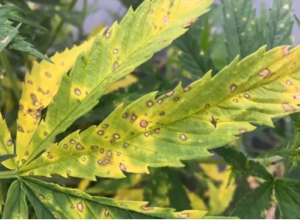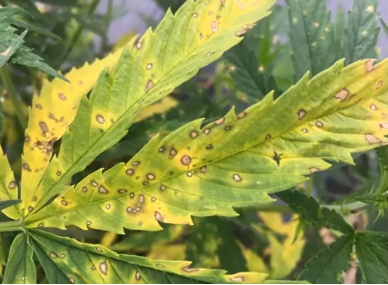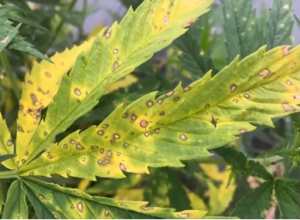5 tips on protecting your hemp crops from diseases
FeaturedIndustrial Hemp NewsMarijuana Laws, Regulations, & Politics August 5, 2020 MJ Shareholders 0



Courtesy of Penn State University
For a while now there’s been an incorrect yet popular belief that hemp plants have no diseases and don’t need pesticides or fertilizers.
Although that mythology has persisted, horticulturists and farmers with experience growing hemp know the plant is vulnerable to diseases and disorders just like other crops, if not given proper care and attention.
“We do know there’s a bunch of (diseases). But we also know, farming for the last however many hundreds of years, that we can manage these things,” said Alyssa Collins, an associate professor at the Department of Plant Pathology and Environmental Microbiology in Penn State University.
Some common causes of plant disease include fungi, bacteria, and nematodes, she said.
Collins recently shared advice on how to manage hemp crops and ensure diseases or disorders don’t ruin them. Below are five of her best tips, edited for length and clarity:
Prevention worth more than the cure
Collins said it’s important to quickly eliminate or reduce initial inoculum, or disease starters.
“Inoculum is just that little spore or cell or whatever is coming in and causing the disease in the first place, so usually with fungi it’s spores or pieces of the fungus.

Alyssa Collins
Then we can also see if we can reduce the effectiveness of that initial inoculum – so preventing its spread within the plant and to other plants by doing things like modifying the environment, making sure we have lots of air flow, growing in a temperature that is not so good for the pathogen, but maybe a lot better for the plant. …
“We can also induce resistance with certain applications of chemicals that turn on the plant’s defense mechanisms.”
Start clean, stay clean
Hemp producers should prioritize sourcing clean plants to start, opting for certified seeds, never planting hemp in the same field back-to-back, and choosing disease-resistant cultivars when available.
That last piece of advice might be a bit tough to pull off, though.
“We’re not there yet in the industry where we have disease-resistant cultivars,” Collins said.
“We’re still trying to get to a point where we have varieties, like truly accepted varieties at all, so it’s gonna be a few years before we are very confident that ‘Hey, this is a resistant variety.’”
Optimize field conditions
Growers can maximize environmental conditions for the plant by choosing a well-drained field, Collins said.
“Our friends in Europe plant varieties that are more like grain and fiber types once the soil gets to around 55 degrees. Some of the CBD varieties probably would prefer it a little warmer, and at least out of that period where it’s going to be raining day after day, that we typically get in the spring,” she said.
“So not only do we want to wait until the soil temperatures warm a bit, we also probably want to wait for optimal soil moisture, which means not too dry, not too wet. I know, it’s the perfect Goldilocks that never seems to exist.”
Do not crowd plants
Give plants enough growing room to allow airflow between them, which will help eliminate the breeding grounds for the most common, fungus-related diseases.
“By the time you’re getting to harvesting the flowers, those plants are all into each other, and that’s shutting down air flow,” Collins said.
“Fungi love moisture, and anyone who’s got a basement knows this; anyone who’s ever gotten athlete’s foot knows this. It’s the same deal on plants, so just think about plant diseases as gross athlete’s foot. You gotta keep the air flow moving. Let ’em breathe.”
Scout your crop early and often
Pay attention and read the field by scouting at least once a week and monitoring weather conditions, Collins advised.
“You get into a pattern with weather where you’re seeing moisture all the time, or dryness all the time. Figure out what that means for your plants and the disease pressure in there,” she said.
Pathogens like fungi and bacteria love moisture and spread easily in wet weather.
“When we have long periods of leaf wetness – that’s when they’re able to infect … (hemp) doesn’t really need that much (moisture) to get up and out.
Conversely, hemp is highly drought-tolerant, Collins said.
“Our colleagues in Arizona have been studying this, and they’ve seen throughout the vegetative stages they can tolerate a lot of drought, and they’ll just be fine,” she said.
“But once they go into that reproductive stage, that’s when we start to see issues with quality and with wilt, because they need to support that reproductive growth.”
You can watch Collins’ full presentation here.
Ivan Moreno can be reached at [email protected]
MJ Shareholders
MJShareholders.com is the largest dedicated financial network and leading corporate communications firm serving the legal cannabis industry. Our network aims to connect public marijuana companies with these focused cannabis audiences across the US and Canada that are critical for growth: Short and long term cannabis investors Active funding sources Mainstream media Business leaders Cannabis consumers










No comments so far.
Be first to leave comment below.